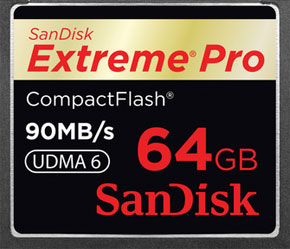
|

|

|


|

|

|
Which Compact Flash card for your digital camera?
There are numerous CompactFlash cards available today.
There are a few key points to remember—
- Not all cameras work well (or at all) with all cards. For example, the Nikon D3x did not work with the SanDisk 64GB card until Nikon issues a firmware update;
- A card that is fast in one camera will probably be fast in others, but might be slower with certain cameras; speed is not guaranteed;
- Never trust speed claims; try with your camera and your card reader.
- For most photographers, there is exactly zero benefit to getting the very fastest and most expensive cards; get last year’s model and save a bundled;
- There are counterfeit cards out there! If it’s an unbelievably good deal, beware.
- Stick with what works: I’ve used SanDisk for years now without trouble.
SanDisk 64GB and 32GB Extreme Pro 90MB/sec cards
The SanDisk Extreme Pro CompactFlash cards appeared in late 2009. I tested them in my Nikon D3x, a Nikon D3s and a Canon 5D Mark II and 1Ds Mark III.
The Canon 5D Mark II and Canon 1Ds Mark III both formatted and worked without a hitch with the 64GB SanDisk Extreme Pro card. So did the Nikon D3s.
The Nikon D3x formatted the 64GB card, but refused to operate with it, flashing a “Cd” error. This was fixed with the January 2010 firmware update, but it came after I returned the card, so I could not independently verify it. The Nikon D3x did work just fine with the 32GB Extreme Pro card.
Speed in camera
All the cameras felt speedy with the cards, much more responsive than my 16GB SanDisk Extreme III cards (which are also slow in my card reader).
With the Nikon D3s, once the buffer fills up, the San Disk Extreme Pro was able to maintain what seemed to be twice the frame rate of the Extreme III, a big deal for sports shooters (I didn’t actually time it, but it was substantially faster). However, the previous generation Extreme IV card seemed pretty close in behavior.
My feeling is that sports and wildlife shooters should be looking at the Extreme Pro cards (assuming a current camera that can make use of them), but most shooters can do just fine with the regular “Extreme III” or “Extreme IV” cards.
On the flip side, DSLRs might soon be heading towards 30 megapixels, medium format makes humongous files, and these new Extreme Pro cards will be good for years to come, so it’s not a bad idea to get the fastest cards now, especially if you might upgrade to a new camera in the next year. It’s really a question of cost, and whether your camera supports these new sizes.
Where to buy
For your convenience, I’ve prepared a list of these two cards and others of different sizes and speeds and capacities at B&H Photo.





















